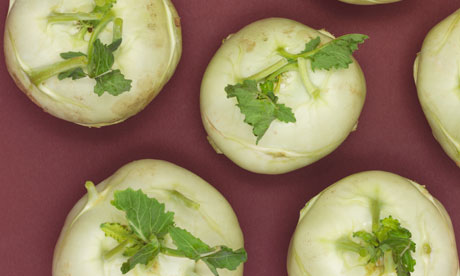
Germans and eastern Europeans are familiar with kohlrabi, but even though it crops easily and reliably in the UK, it might as well be an alien sputnik here. This spherical vegetable, either eau-de-nil or magenta in colour, is actually a cabbage, although it looks more like a white turnip. Poles crunch into it raw and unskinned, like an apple. Kohlrabi is also prized in north Indian cuisine, where it is cut into segments and cooked in spicy gravy, with its willowy stems and leaves still attached.
The kohlrabi bulb most resembles cabbage heart and broccoli stem in taste terms, but is much sweeter and juicier. Wonderfully crunchy served raw in salads, or with dips, it makes an ideal portable snack. Roasting brings out its deeper brassica flavour. Don't bin the leaves – they make a novel substitute for kale or spring greens.
Why is kohlrabi good for me?
Kohlrabi is an exceptionally rich source of vitamin C; more so than oranges. This powerful antioxidant vitamin is vital for healthy connective tissue, teeth and gums, boosts immunity and so is protective against many diseases. In common with other brassicas, kohlrabi contains health-promoting phytochemicals that appear to have an anti-cancer and anti-inflammatory effects. Chronic, low-level inflammation could raise your risk of heart disease, stroke, diabetes, Alzheimer's, osteoporosis and other common diseases.
Where to buy and what to pay
Kohlrabi is a staple of organic veg box schemes, one of those puzzling "how do I cook this?" items. Organic vegetable market stalls often sell it at a liberatingly low price. Supermarkets don't usually stock it; enterprising greengrocers and Asian food shops do. Guide price: £2-£3.99 per kg.
Joanna Blythman is the author of What To Eat (Fourth Estate, £9.99). To order a copy for £7.99 with free UK p&p, go to guardianbookshop.co.uk
Kohlrabi, cucumber and little gem with elderflower dressing
Crisp kohlrabi is a fantastic salad ingredient. Since elderflowers are now blossoming, you could try making the syrup to use in this dressing, but it's more than acceptable to use elderflower cordial instead.
Serves 4
For the salad
2 small kohlrabi, peeled, thinly sliced
1 small cucumber, peeled, deseeded and cut into semicircles
1 bunch of chives, chopped
2 heads little gem lettuce, trimmed, washed and dried
100g stale bread, cut into cubes, tossed in 1 tbsp of olive oil and seasoning, then baked until crisp
For the dressing
8 heads elderflower, stalks removed, rinsed, plus 1 tbsp sugar (or 1½ tbsp elderflower cordial)
Juice and zest of 1 lemon
1 heaped tsp Dijon mustard
100ml flavourless oil
60ml fruity olive oil
1 First make the elderflower juice for the dressing. Boil the kettle and pour 500ml of water on to the elderflower heads and lemon zest. Cover and leave to steep for several hours or overnight.
2 Strain the flowers and zest through a fine sieve. Add the liquid to a pan along with the lemon juice and sugar, then bring to the boil. Simmer until reduced by half. Set aside to cool.
3 Meanwhile, put the salad ingredients in a large bowl and season well.
4 Put the mustard, oil, vinegar and cooled elderflower liquid into a jar and shake thoroughly. Taste and season if necessary.
5 Add 2 tbsp dressing to the big bowl and toss together thoroughly, adding more dressing and seasoning as necessary.
6 Serve as a starter or as the accompaniment to plain, grilled fish or meat and some buttered warm new potatoes with mint.
Rosie Sykes is head chef of Fitzbillies (fitzbillies.com) and co-author of The Kitchen Revolution (Ebury Press, ££27.50). To order a copy for £20 with free UK p&p, go to guardianbookshop.co.uk

